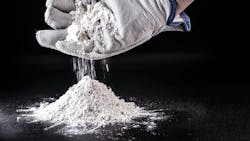Solids Processing: Measure The Basics to Succeed
Key Takeaways
- Designing new particulate solids processes is easier than fixing existing ones due to better access to critical physical property data.
- Understanding moisture variation, particle size distribution and solids loading is essential for effective process design and troubleshooting.
- Equipment arrangements should consider trade-offs, as optimizing one process step may create new challenges in downstream operations.
Designing a new process for producing particulate solids is often easier than fixing or modifying an existing process. Solids processing is a unique technical field. Many of the important properties needed to understand a flow problem or a product quality issue are not easily determined. The most common complaint for an existing process is that the product has changed, while there has not been any change in the process or ingredients. What they are really saying is that our understanding of the process is missing some physical data, such as a polymorph or an enantiomer.
Determining the physical properties of particulate solids is generally prohibitively expensive (think solubility of all polymorphs), so we get what we can and move on when developing the original process. The problem with an existing process is that the developers have moved on, and the current operators have tweaked the process with little documentation. In today’s chemical processes, those tweaks would be documented or evaluated before starting the process.
While in college, I worked part-time for a chemical plant and observed how each shift had its own settings for steam pressure, drum rotation speed, grid pressure drop and many other parameters. Mind you, none of these settings were outside “good practice,” and many of them didn’t change the product. However, over the years, these subtle changes would become standard practice. I recall a process where the product analysis of a crystallizer output came back from the lab at 10% unknown. This had been increasing for several months. It turns out those little changes caught up and shifted the equilibrium of a side-stream reaction. That experience reminds me that you can’t do research in a production environment.
Fluids have a limited ability to carry solids.
Solids Processing Design Parameters
However, designing a new process opens the door to getting more of the important and common physical properties required to understand a solids processing operation. Let’s start with the basics:
- Moisture and how it varies in the bulk material and within the particles
- Particle size and distribution in each step of a process
- Solids loading at various stages of the process
Most plants can give you basic numbers for these properties. However, these properties are often not a single number but a range of numbers.
Moisture: This varies throughout a batch and within the particles. We had a clumping problem with material stored for a period after drying. In that case, the important parameter was the critical moisture. After the crystallizer, the filtration unit had a wet cake of moisture well above the critical moisture. However, it did vary over time. Research had determined that the drying time of 30 minutes was sufficient to reach the desired final product moisture. This worked well for several years.
Filters deteriorate over time, and cloth material can vary in quality even when new. One day, a clumping problem cropped up due to increased wet-cake moisture. Increasing the drying time caused clumping in the dryer and some product damage. The fine particles were dry, but some of the larger particles were still just below the critical moisture.
The problem was resolved by monitoring the solids temperature to ensure it was above the dew point in the dryer and using a fixed drying time from that point on. Since critical moisture is reached, drying occurs in the falling-rate zone without overheating the solids. This process should have been designed with a control that varied the drying time to account for the constant rate drying period that changed with the starting moisture.
Particle Size Distribution: As with moisture, particle size is not a single number, but a range of values. Unfortunately, the range can change during processing due to attrition and agglomeration. The particle size distribution can affect the drying rate and the product quality. Fine particles may over-dry or have the surface harden, reducing the solubility.
Meanwhile, larger particles end up with residual moisture that can cause clumping. At low concentration, particles in a slurry or suspension behave as single particles in a fluid. They start to behave like larger particles as the concentration rises, and then they settle faster. This effect can cause a fluid bed to collapse or a pneumatic conveyor to plug up.
Solids Loading: Fluids have a limited ability to carry solids. As the solids-to-gas ratio increases, flow changes from a fluid-like motion to slugs. On one hand, this is a good characteristic as the particles will slow down and experience less attrition. The negative side is that piping may need additional supports to prevent slug damage.
Fortunately, it is well understood how the particles flow based on particle size and density. The Geldart diagram, in combination with the saltation velocity, can be used to predict the no-flow region or the limited carrying capacity of a fluid.
Other Considerations
Another thing to consider when designing or troubleshooting a process is the equipment arrangement. While I’ve seldom seen a piece of equipment that wasn’t doing what it was supposed to do, it may be overextended. For example, running a crystallizer to produce a large particle that will reduce filtration time could result in more fine particles from the dryer because of attrition.
A better route may be to run the crystallizer to make smaller particles and agglomerate these into larger particles in the dryer. To evaluate this option, you may need a filtration study to determine the optimum particle size at which you would run the crystallizer to prevent overloading the centrifuge or filter.
Data for solids processing design or troubleshooting can be expensive to obtain, but by looking at alternative routes and paying attention to the three basic particle characteristics, you can focus on the most important parameters. This will give you the best data.
About the Author
Tom Blackwood, Solids Advice columnist
Contributing Editor
Tom Blackwood, a veteran engineer who has dealt extensively with solids over the course of his career, contributes regularly to Chemical Processing and serves as the Solid Advice columnist.

